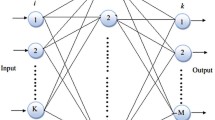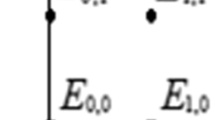Abstract
A geomagnetic storm is a brief disruption in the magnetosphere of the Earth that depresses the magnetic field. This activity causes variations in the ionospheric Total Electron Content (TEC) and other physical properties because it is connected to solar coronal mass ejections, coronal holes, or solar flares. A modeling method called a Neural Network (NN) displays nonlinear characteristics which include physical variables. The present research aims to develop a feed-forward back-propagation neural network-based forecasting approach to ionospheric TEC throughout a geomagnetic storm. We have contrasted the TEC gained through neural network estimation (NN TEC), GPS TEC, and NeQuick TEC via the IRI model during four intense geomagnetic storms on June 23, 2015 (Kp index of 8.33 and Dst index −198 nT), December 20, 2015 (Kp index of 6.67 and Dst index −166 nT), May 28, 2017 (Kp index of 7.0 and Dst index −125 nT) and August 26, 2018 (Kp index of 7.67 and Dst index −175 nT) across two Indian stations Bangalore (Geog. latitude 12∘, 58’N, longitude 77∘, 35’E), and Lucknow (Geog. latitude 26∘, 50’N, longitude 80∘, 55’E) and analysis have been made. It is observed that modeled NN TEC values, and GPS TEC values, match well during the entire duration of all the geomagnetic storms at both stations. Whereas, except for the geomagnetic storm beginning phase, NeQuick TEC has been underestimated during the entire event across Bangalore and Lucknow during the selected intense geomagnetic storms. It is noted that Lucknow’s maximum deviation of NN and GPS TEC is higher than Bangalore’s. The greatest correlation coefficient 0.99, was found and shows that the modeled NN TEC values, and GPS TEC values, are in excellent agreement. In order to assess the preciseness of the model’s output, Root Mean Square Error (RMSE) and Mean Absolute Percentage Error (MAPE) values were used to compare the projected TEC relative to the measured GPS-TEC and NeQuick TEC model output. The RMSE value of the NN model is shown to be lower throughout the storm’s initial and final phases, but greater throughout its main phase. Additionally, it is found that throughout the intense geomagnetic storms, Lucknow’s RMSE and MAPE values were higher than Bangalore’s. As a result, when compared to the NeQuick approach, the NN method demonstrated greater accuracy and TEC estimations. The present research concludes that neither the NN nor the NeQuick models can accurately forecast ionospheric TEC for an equatorial station (Bangalore) and an equatorial ionization anomaly (EIA) station in Lucknow throughout intense geomagnetic storms. However, during the recovery period (post-storm), the precision of the forecast increased.











Similar content being viewed by others
Data Availability
The geomagnetic data are freely available on the website (https://wdc.kugi.kyotou.ac.jp/) and the Omni website (https://omniweb.gsfc.nasa.gov/form/dx1. HTML). The GPS data in RINEX FORMAT were freely available at the IGS website at ftp:/garner.ucsd.edu.
References
Akir, R.M., Abdullah, M., Chellapan, K., Bahari, S.A., Homam, M.J., Ngadengon, R.: Forecasting Ionospheric Total Electron During Geomagnetic Storms. IEEE Student Conference on Research and Development (SCOReD), Johar Malaysia (2020)
Amaechi, P.O., Oyeyemi, E.O., Akala, A.O.: The response of African equatorial/low-latitude ionosphere to 2015 St. Patrick’s Day geomagnetic storm. Space Weather 16, 601–618 (2018)
Andima, G., Amabayo, E.B., Jurua, E., Cilliers, P.J.: Modelling of GPS total electron content over the African low-latitude region using empirical orthogonal functions. Ann. Geophys. 37, 65–76 (2019)
Bilitza, D., Altadill, D., Zhang, Y., Mertens, C., Truhhlik, V., Richards, P., McKinnell, L., Bodo, R.B.: The international reference ionosphere 2012- a model of international collaboration. J. Space Weather Space Clim. 4, A07 (2014)
Bilitza, D., Altadill, D., Truhlik, V., Shubin, V., Galkin, I., Reinisch, B., Huang, X.: International reference ionosphere 2016: from ionospheric climate to real-time weather predictions. Space Weather 15, 418–429 (2017)
Birch, M.J., Hargreaves, J.K., Bailey, G.J.: On the use of an effective ionospheric height in electron content measurement by GPS reception. Radio Sci. 37, 1–19 (2002)
Bolaji, O.S., Adekoya, B.J., Adebiyi, S.J., et al.: The African equatorial ionization anomaly response to the St. Patrick’s Day storms of March 2013 and 2015. Astrophys. Space Sci. 367, 1 (2022)
Cander, L.R.: Artificial neural network applications in ionospheric studies. 41, 5–6 (1998)
Chaurasiya, S.K., Patel, K., Kumar, S.A.K.: Ionospheric response of St. Patrick’s Day geomagnetic storm over Indian low latitude regions. Astrophys. Space Sci. 367, 103 (2022b)
Chaurasiya, S.K., Patel, K., Singh, A.K.: Equatorial plasma bubbles for solar maximum & moderate year of solar cycle 24. Adv. Space Res. 70, 2856–2866 (2022a)
Dabbakuti, J.R.K., Mallika, Y., Venugopala Rao, M., Raghava Rao, K., Venkata Ratnam, D.: Modeling of GPS-TEC using QR-decomposition over the low latitude sector during disturbed geomagnetic conditions. Adv. Space Res. 64, 2088–2103 (2019). https://doi.org/10.1016/j.asr.2019.08.020
Dabbakuti, J.R.K.K., Peesapati, R., Arrakula, M.Y., Kumar, K., Madduri, S.: Implementation of storm-time ionospheric forecasting algorithm using SSA–ANN model. IET Radar Sonar Navig. (2020). https://doi.org/10.1049/iet-rsn.2019.0551
Dugassa, T., Giday, N., Habarulema, J., Habyarimana, V., Oljira, A.: Ionospheric response to the 23-31 August 2018 geomagnetic storm in the Europe-African longitude sector using multi-instrument observations. Adv. Space Res. (2022)
Fausett, L.: Fundamentals of Neural Networks: Architectures, Algorithm and Applications. Prentice-Hall, New Jersey (1994)
Habarulema, J.B., McKinnell, L.A., Cilliers, P.J.: Prediction of global positioning system total electron content using neural networks over South Africa. J. Atmos. Sol.-Terr. Phys. 69(15), 1842–1850 (2007)
Habarulema, J.B., McKinnell, L.A., Opperman, B.D.L.: Towards a GPS-based TEC prediction model for Southern Africa with feed-forward networks. Adv. Space Res. 44(1), 82–92 (2009)
Haykin, S.: Neural Networks, a Comprehensive Foundation. Macmillan Co., New York (1994)
Homam, M.J.: Initial prediction of Total Electron Content (TEC) at a low latitude station using neural network. In: IEEE Asia-Pacific Conference on Applied Electromagnetics, Johor Bahru, Malaysia, 8–10 December, 2014, pp. 111–114 (2014)
Jain, S., Vijay, S.K., Gwal, A.K.: An empirical model for IEC over Lunping. Adv. Space Res. 18(6), 263–266 (1996)
Kelley, M.C., Fejer, B.G., Gonzales, C.A.: An explanation for anomalous equatorial ionospheric electric field associated with award turning of the interplanetary magnetic field. Geophys. Res. Lett. 6(4), 301 (1979)
Kuai, J., Liu, L., Liu, J., Sripathi, S., Zhao, B., Chen, Y., Le, H., Hu, L.: Effects of disturbed electric fields in the low-latitude and equatorial ionosphere during the 2015 St. Patrick’s Day storm. J. Geophys. Res. Space Phys. 121, 9111–9126 (2016)
Kumar, S.: Performance of IRI-2012 model during a deep solar minimum and a maximum year over global equatorial region. J. Geophys. Res. Space Phys. 121(6), 5664–5674 (2016)
Kumar, S., Singh, A.K.: Storm time response of GPS- derived total electron content (TEC) during the low solar active period at low latitude station Varanasi. Astrophys. Space Sci. 331(2), 447–458 (2010)
Kumar, S., Tan, E.L., Razul, S.G., See, C.M., Singh, D.: Validation of the IRI-2012 model with GPS-based ground observation over a low latitude Singapore station. Earth Planets Space 66, 17 (2014)
Lera, G., Pinzolas, M.: Neighborhood based Levenberg-Marquardt algorithm for neural network training. IEEE Trans. Neural Netw. 13(5), 1200–1203 (2002)
Liu, L., Wan, W., Zhang, M.-L., Zhao, B.: Case study on total electron content enhancements at low latitudes during ow geomagnetic activities before the storms. Ann. Geophys. 26(4), 893–903 (2008)
Mannucci, A.J., Wilson, B.D., Edwards, C.D.: a new method for monitoring the Earth’s ionospheric total electron Content using the GPS global network. Paper presented at ION GPS-93, Inst. of Navig., Salt Lake City, Utah, 22–24 Sept. Pp. 1323–1332 (1993)
Mark, B.: Neural Network Toolbox for Use with MATLAB. The Mathworks, Natick (2002)
Moses, M., Dodo, J.D., Ojigi, L.M., Lawal, K.: Regional TEC modeling over Africa using deep structured supervised neural network. Geod. Geodyn. 11(5), 367–375 (2020)
Naggar, A.M.: Artificial neural network as a model for ionospheric TEC map to serve the single frequency receiver. Alex. Eng. J. 52(3), 425–432 (2013)
Nelles, O.: Nonlinear System Identification. Springer, Heidelberg (2001)
Okoh, D., Owolabi, O., Ekechukwu, C., Folarin, O., Arhiwo, G., Agbo, J., Bolaji, S., Rabiu, B.: A regional GNSS-VTEC model over Nigeria using neural networks: a novel approach. Geod. Geodynam. 7(1), 19–31 (2016)
Rao, S.S., Chakraborty, M., Singh, A.K.: Observed (GPS) and modeled (IRI and TIE-GCM) TEC trends over southern low latitude during solar cycle-24. Adv. Space Res. (2022)
Rawer, K., Bilitza, D., Ramakrishnan, S.: Goals and status of the international reference ionosphere. Rev. Geophys. 16, 177–181 (1978)
Reddybattula, K.D., Panda, S.K., Sharma, S.K., Singh, A.K., Kurnala, K., Sri Haritha, C., Wuyyuru, S.: Anomaly effects of 6-10 September 2017 solar flares on ionospheric total electron content over Saudi Arabian low latitudes. Acta Astronaut. S0094576520304720 (2020)
Sahu, S., Trivedi, R., Choudhary, R.K., Jain, A., Jain, S.: Prediction of Total Electron Content (TEC) using neural network over anomaly crest region Bhopal. Adv. Space Res. (2021)
Singh, P.K.: Prediction of intensity of moderate and intense geomagnetic storms using artificial neural network during two complete solar cycles 23 and 24. Indian J. Phys. 96, 2235–2242 (2022)
Singh, G., Singh, A.K.: A study on precursors leading to geomagnetic storms using artificial neural network. J. Earth Syst. Sci. 125(5), 899–908 (2016)
Singh, A., Rathore, V.S., Kumar, S., Rao, S.S., Singh, S.K., Singh, A.K.: Effect of intense geomagnetic storms on low-latitude TEC during the ascending phase of the solar cycle 24. J. Astrophys. Astron. 42(2), 99 (2021)
Sulungu, E.D., Uiso, C.B.S.: Total electron content prediction model using the artificial neural networks over Africa region. Tanzan. J. Sci. 45(3), 502–517 (2019)
Tang, J., Gao, X., Yang, D., Zhong, Z., Huo, X., Wu, X.: Local persistent ionospheric positive responses to the geomagnetic storm in August 2018 using BDS-GEO satellites over low-latitude regions in Eastern Hemisphere. Remote Sens. 14, 2272 (2022)
Tulasiram, S., Gowtam, V.S., Mitra, A., Reinisch, B.: The improved two-dimensional Artificial Neural Network-Based Ionospheric Model (ANNIM). J. Geophys. Res. Space Phys. 123, 5807–5820 (2018)
Unnikrishnan, K., Haridas, S., Choudhary, R.K., Bose, P.D.: Neural network model for the prediction of TEC variabilities over Indian equatorial sector. Indian J. Sci. Res. 18(1), 56–58 (2018)
Wan, Q., Ma, G., Li, J., Wang, X., Lu, W., Maruyama, T., Fan, J., Zhang, J.: Performance evaluation of IRI-2016 with GPS-derived TEC at the meridian of 110oE in China of 2014. J. Atmos. Sol.-Terr. Phys. 201, 105206 (2020)
Watthanasangmechai, K., Supnithi, P., Lerkvaranyu, S., Tsugawa, T., Nagatsuma, T., Maruyama, T.: TEC prediction with neural network for equatorial latitude station in Thailand. Earth Planets Space 64, 473–483 (2012)
Wen, Z., Li, S., Li, L., Wu, B., Fu, J.: Ionospheric TEC prediction using long short-term memory deep learning network. Astrophys. Space Sci. (2021)
Yang, D., Fang, H., Liu, Z.: Completion of global ionospheric TEC maps using a deep learning approach. J. Geophys. Res. Space Phys. 127 (2022)
Yilmaz, A., Akdogan, K.E., Gurun, M.: Regional TEC mapping using neural networks. Radio Sci. 44 (2009)
Zhima, Z., Hu, Y., Shen, X., Chu, W., Piersanti, M., Parmentier, A., Zhang, Z., Wang, Q., Huang, J., Zhao, S., Yang, Y., Yang, D., Sun, X., Tan, Q., Zhou, N., Guo, F.: Storm-time features of the Ionospheric ELF/VLF waves and energetic electron fluxes revealed by the China seismo-electromagnetic satellite. Appl. Sci. (2021)
Acknowledgements
The work is partially supported by SERB, New Delhi for the CRG project (File No: CRG/2019/000573) and partially by the Institute of Imminence (IoE) Program (Scheme No: 6031) of BHU, Varanasi.
Author information
Authors and Affiliations
Contributions
Sunil Kumar Chaurasiya: Formal analysis, Plotting graphs, Data curation, Writing-Original draft preparation. Kalpana Patel: Writing- Reviewing, plotting and Editing. Abhay Kumar Singh: Writing- Reviewing, Conceptualizing, Supervision, and Editing.
Corresponding author
Ethics declarations
Competing interests
The authors declare no competing interests.
Additional information
Publisher’s Note
Springer Nature remains neutral with regard to jurisdictional claims in published maps and institutional affiliations.
Rights and permissions
Springer Nature or its licensor (e.g. a society or other partner) holds exclusive rights to this article under a publishing agreement with the author(s) or other rightsholder(s); author self-archiving of the accepted manuscript version of this article is solely governed by the terms of such publishing agreement and applicable law.
About this article
Cite this article
Chaurasiya, S.K., Patel, K. & Singh, A.K. Total electron content forecasting with neural networks during intense geomagnetic storms of the solar maximum and moderate years of solar cycle 24 in the low latitude Indian region. Astrophys Space Sci 368, 79 (2023). https://doi.org/10.1007/s10509-023-04237-8
Received:
Accepted:
Published:
DOI: https://doi.org/10.1007/s10509-023-04237-8




